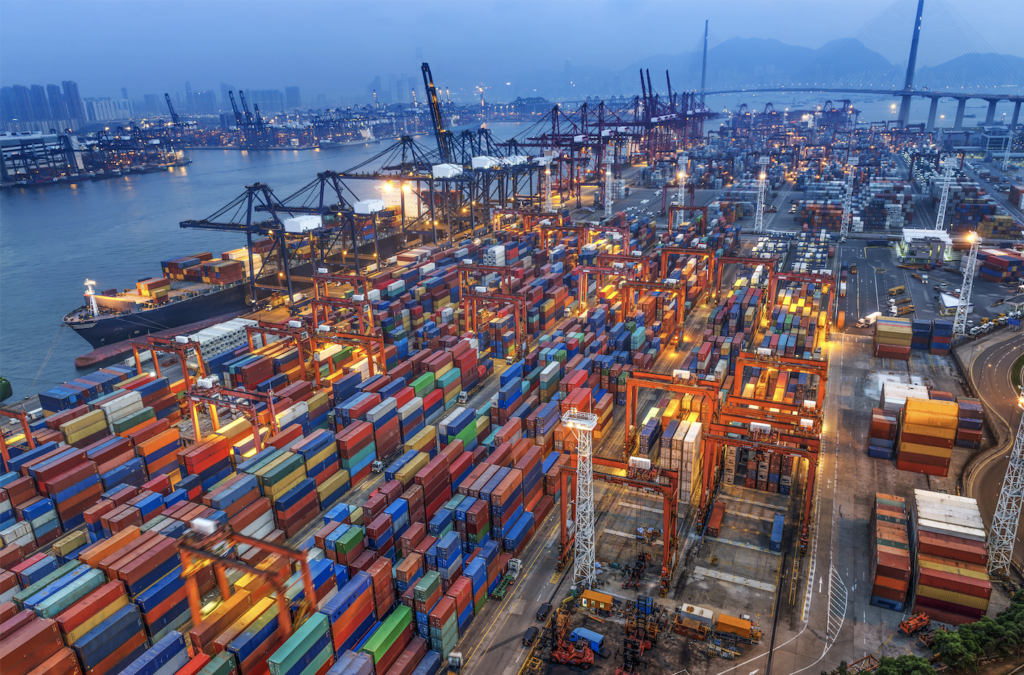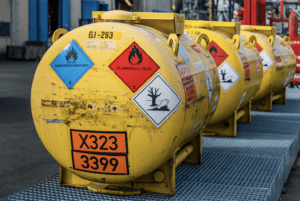As consumer demands rise, and global supply chains expand, all involved parties must understand the risks and responsibilities associated with transporting potentially dangerous materials
It is well known that many of the chemicals and intermediate products that are crucial in many global supply chains, such as battery materials and aerosols, can pose hazards to human health and the environment if not handled properly, both during production and transport. Today, over 400 million lithium-ion batteries and over 15 billion aerosol products are said to be produced annually. Furthermore, there are 451 ultra-large container ships operating currently, with another 129 reportedly on delivery for 2020. [1]

Figure 1. The global nature of today’s expanding supply chains mean that many parties may hold responsibility over the transport of hazardous materials
These staggering numbers suggest that the future holds new levels of risk associated with the shipping and transit of potentially hazardous chemicals and products (Figure 1).
When the need arises for manufacturers, shippers, arrangers and transporters of hazardous materials (the “parties at risk”) to move their goods or services, numerous considerations come into play. These parties should ask themselves the following questions:
- Who will arrange shipment, trans-shipment or temporary storage?
- When does title of ownership transfer?
- What method or methods of conveyance will be utilized?
- What role do terminal operations have in mitigating risk of loss from incorrectly declared cargo?
- Will third-party intermediaries be utilized, such as freight brokers?
- Are my goods or products properly labeled and declared?
- How does my insurance apply and how will the insurance of my counterparties respond?
Often, these and other questions are answered during the preparation of such documents as bills of lading and subsequent contracts of sales or purchase orders. Other times, they are obligations of the parties, are not clearly delineated, and are left to chance. The regulations from governing bodies around the globe can provide a framework to help parse responsibilities. To learn more about the conventions governing global commodities transport, please read Part 2 of this feature, Transporting Hazardous Materials Part 2: Global Conventions on Risk.
When dealing with hazardous cargo, it is essential that all involved parties understand not only the regulatory behavior of governing bodies, but also the risks faced if cargo is not properly declared or if supply-chain disruptions occur.
Business considerations
Two of the most prevalent agreements used for the movement and storage of hazardous materials are charter party agreements and terminal agreements. Each of these agreements contains specific terms and conditions, which outline the obligations of the parties (ship owner “vessel interest” versus shipper “commodity interest”). Ship owner or vessel interest is the party responsible for moving the goods or materials. The shipper is the party or parties responsible for filling the vessel. Oftentimes, shippers do not have ample quantities to fill the entire vessel. In this instance, both the ship owner and shipper would work with a charter party, whose role is to maximize the volume of goods placed on any one vessel by working or contracting with shippers. The charter party is a middleman, in essence. If a shipper could utilize an entire vessel, they would be deemed the chartered party. Sometimes, freight brokers enter into the fray and they assist the charter party by finding shippers in need of a vessel.
The charter party agreement is a contract that defines port of origin and destination, as well as detailed descriptions of goods or cargo. In voyage charter party agreements, the shipper is required to provide safe passage. Furthermore, the charter party agreement contains terms and conditions such as hold harmless and indemnification agreement and force majeure.
Terminal agreements are contracts between the terminal operator and shipper commodity interest to store goods at a specific terminal location for specified goods. These agreements articulate the duties of the terminal operator, such as offloading and transporting goods from flange to tankage, expected annual throughput; costs, fees and expenses associated with storage, evidence of insurance, and limitations of liability including hold harmless and indemnification agreements; and force majeure clauses.
Hold-harmless and indemnification agreements are inserted into contracts to supplement potential insurance recoveries. Insurance does not always respond as intended and these two contract provisions provide an added layer of protection by utilizing the balance sheet of the counterparty to fill potential gaps in insurance recovery.
It is important when creating agreements to consider the following:
- For parties of commercial contracts to understand the enforceability of force majeure clauses varies by regions and wording/intent conflicts can arise in global trade agreements
- To know that when a party or parties declare force majeure, broad indemnification agreements are replaced with knock-for-knock indemnities, which could have significant effect on insurance recovery
Insurance and other risks
Insurance policies are contracts, and like all contracts, they contain limitations. These limitations often can be amplified when the global trade market experiences disruption.
Recent global events have had profound impact on fuel storage — or lack thereof — exacerbating the need for alternative storage, such as rail cars and floating storage. There were at least 160 million barrels of oil stored at sea earlier this year [2]. Commodity interests continue to acquire excess storage capacity in vessels to meet its immediate needs for temporary storage.
Excess supply of oil or other hazardous materials and lack of storage bring environmental risks to the forefront, exposing commodity interests to loss. In order to quantify risks, commodity interests are best served to understand:
- The laws of the land in which hazardous goods or materials are traversing and ultimately traded
- The full breadth of insurance coverage (limits of liability, for example) evidenced by counterparty
- The potential restrictions/limitations in cover and what impact these have on your operations
Additionally, commodity interests can be used to determine trade terms, including who bears responsibility for risk of loss and when the responsibility comes into play.
Insurance policies sometimes restrict coverage for pollution releases while goods or products move through supply chains. A few examples of insurance coverage restrictions/limitations are marine cargo, marine general liability, protection and indemnity, pollution legal liability and professional liability.
Risks from misdeclaration
Misdeclaration of cargo is another risk to consider. Cargo is sometimes misdeclared when the physical goods and the description of these goods are not the same. Such misdeclarations have been the source of a considerable portion of safety incidents on cargo ships [3]. For instance, misdeclared or mislabeled cargo can lead to a ship’s crew not taking proper safe-storage precautions (Figure 2). Misdeclared cargo is sometimes accidental — however, other times, importers and exporters will purposely misidentify their cargo as a way to deceive shippers.

Figure 2. Improperly labeling hazardous cargo can potentially lead to catastrophic results
There are numerous examples where misdeclared cargo resulted in catastrophic loss. A specific example can be seen with the KMTC Hong Kong containership that was docked in Thailand on May 25, 2019. At approximately 6:45 a.m., an explosion occurred, engulfing the ship in flames. By the time the fire was extinguished late in the afternoon, 130 people had already been hospitalized. The investigation team sent to inspect the damage on the KMTC Hong Kong found calcium hypochlorite in 13 containers and chlorinated paraffin wax in five other containers. Investigators concluded that the ignition of these toxic chemicals was the most plausible cause of fire. The fire and the burning chemicals caused noxious smoke and the acidic ashes raining down triggered the evacuation of many communities around the seaport. It was reported that the Thailand Port Authority said the hazardous goods on board the KMTC ship were not declared, and that some of the containers were said to contain dolls [4].
The consequence of misdeclared cargo can be dire to people, the environment and the financial viability of all parties involved. The highest severity of harm from any fire is loss of life — in a 2012 incident, several crew members died and others were injured when an explosion occurred in the early stages of fire-fighting. In another incident, a crewmember suffered fatal injuries due to a secondary explosion involving calcium hypochlorite.
Container fires also have an environmental impact, including from all the waste generated from burnt and wet material. The extreme heat generated during many hold fires often means that marine salvage workers resort to flooding the cargo spaces with water to contain and extinguish the fire. The 2012 case mentioned above involved disposal of some 8,000 metric tons of scrap, 350 metric tons of hazardous waste and 30,000 cubic meters of contaminated fire-fighting water. Disposing of waste is also becoming increasingly costly. In a recent case in Europe, the disposal of some 130 containers and 5,000 cubic meters of fire-fighting water cost nearly $10 million.
Added to the cost of the damage to the vessel, loss of earnings, cargo damage, salvage and general average expenditure, it is not difficult to see why such cases can become the subject of ongoing litigation involving hundreds of millions of dollars and countless law firms. As larger-capacity ships take the seas, costs and losses will escalate significantly.
Parties at risk, such as vessel/cargo/finance/terminal interests, are becoming increasingly aware of the damages (financial, human health and environment) caused by misdeclared cargoes. Governments have been increasingly more vocal. Further exacerbating supply-chain risks are market disruptions, much like we are currently experiencing with COVID-19 and the onslaught of the oil trade war between Saudi Arabia and Russia. In the course of 60 days, global crude demand plummeted, which strained storage capacity and forced commodity interests to find alternative storage on land or at sea. Given the lack of storage supply, traders may have been forced to accept punitive contract terms, which might not be fully transferable to insurers. Potential gaps in insurance coverage equate to increased balance sheet stress via indemnification obligations.
Trade and insurance go hand in hand and both should be fluid enough to respond to ever changing market conditions. Counterparty risk often challenges the premise of insurance and this is especially true when it comes to environmental releases. Verifying the existence of parties in the chain is no longer acceptable. It is in the best interests of shippers to fully understand the breadth of insurance placed for the benefit of their agents, vendors or third party professionals in order to make informed decisions. ♦
Edited by Mary Page Bailey
References
- Lawrence, Nigel, Editor’s Log, Shipping Today and Yesterday, July 2018.
- Ambrose, Jillian, Oil Market Faces Storage Crisis in a World Awash with Crude, The Guardian, April 25, 2020.
- Samuels, Chase, The Dangers of Misdeclared Cargo, Trade Risk Guaranty, Oct. 25, 2019.
- Rujivanarom, Pratch, Toxic Chemical Caused Seaport Fire, The Nation Thailand, May 26, 2019.
Author
 Christopher Alviggi is senior vice president and Environmental Insurance Practice leader at insurance broker and consultant firm NFP Corp. (Phone: 732-913-9881; Email: chris.alviggi@nfp.com). He has more than 20 years of accretive commercial insurance brokerage experience, which includes a breadth of insurances, each with unique risk profiles. His broking experience includes: casualty risk management accounts, including mergers & acquisitions; construction and capex projects both domestic and internationally; oil and gas/natural resources; and environmental risk. Chris earned an M.B.A. in international finance/risk management and a B.S. in finance from the College of Insurance, which is now part of St John’s University in Queens, N.Y.
Christopher Alviggi is senior vice president and Environmental Insurance Practice leader at insurance broker and consultant firm NFP Corp. (Phone: 732-913-9881; Email: chris.alviggi@nfp.com). He has more than 20 years of accretive commercial insurance brokerage experience, which includes a breadth of insurances, each with unique risk profiles. His broking experience includes: casualty risk management accounts, including mergers & acquisitions; construction and capex projects both domestic and internationally; oil and gas/natural resources; and environmental risk. Chris earned an M.B.A. in international finance/risk management and a B.S. in finance from the College of Insurance, which is now part of St John’s University in Queens, N.Y.